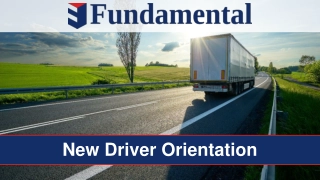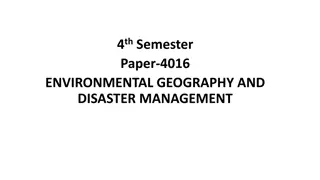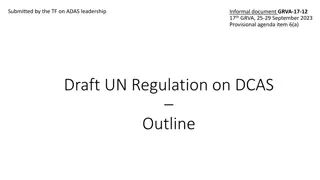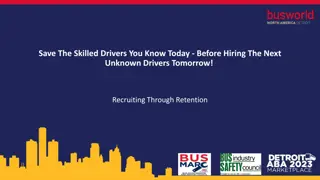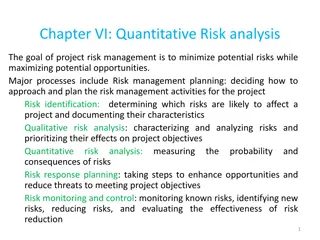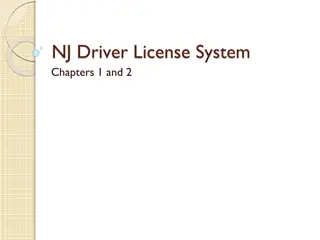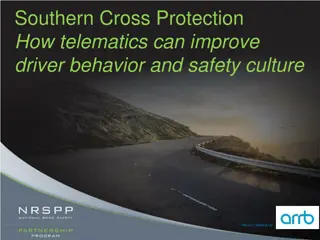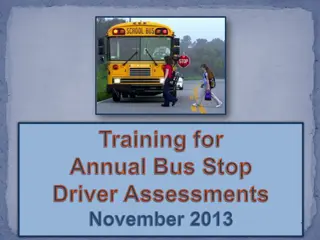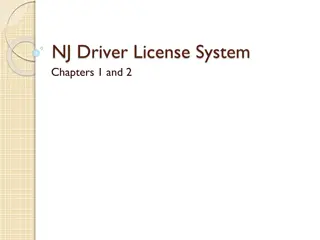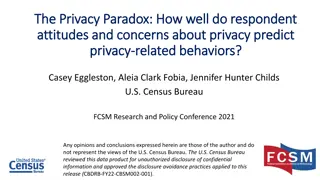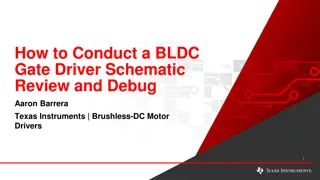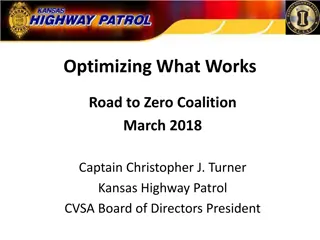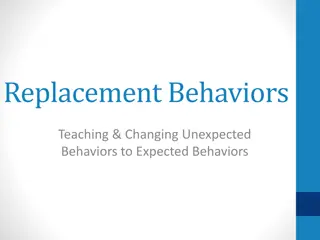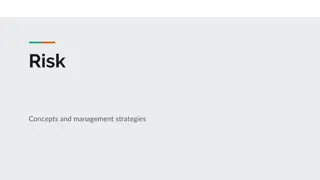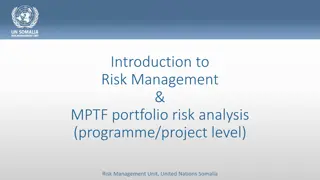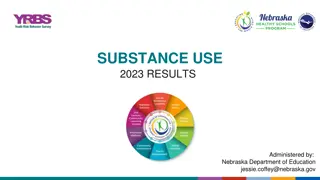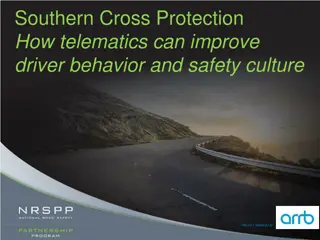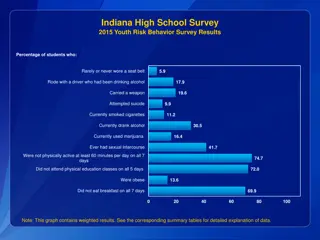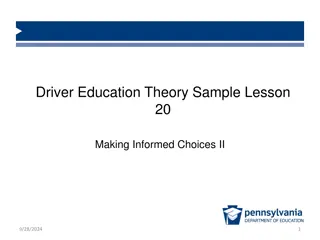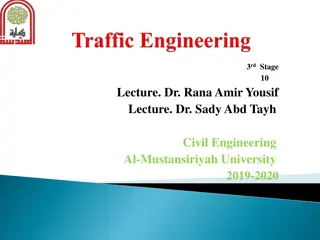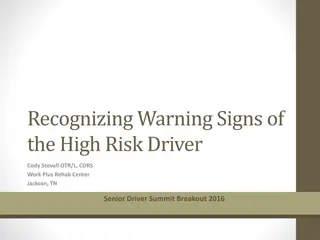Developing Reduced-risk Behaviors in Driver Education: Factors and Strategies
Explore key topics in driver behavior such as fatigue management, recognizing poor driving behavior, anger management, and handling unusual roadway conditions. Understand the definition of fatigue, its causes, physical, and mental symptoms, and tips to delay its onset for safer driving practices.
Download Presentation

Please find below an Image/Link to download the presentation.
The content on the website is provided AS IS for your information and personal use only. It may not be sold, licensed, or shared on other websites without obtaining consent from the author. Download presentation by click this link. If you encounter any issues during the download, it is possible that the publisher has removed the file from their server.
E N D
Presentation Transcript
Driver Education Theory Sample Lesson 17 Developing Reduced-risk Behaviors: Factors that can Influence Behaviors 9/1/2024 1
Developing Reduced-risk Behaviors: Factors that can Influence Behaviors Topic 1 Forever A Child Topic 2 Session Assessment Topic 3 Fatigue and Driver Behavior Topic 4 Recognizing Poor Driver behavior Topic 5 Anger Management and Driver Behavior Topic 6 Unusual Roadway Conditions 9/1/2024 2
Introduction Alcohol Review Forever A Child Managing Fatigue Managing Anger Managing Roadway Conditions 9/1/2024 3
Definition of Fatigue Fatigue is A Body Response Follows a Period of: Extended mental activity Extended bodily activity Characterized by: Reduced capacity for work Reduced efficiency of accomplishment 9/1/2024 4
Causes of Fatigue Extended Physical Activity Disruption of Circadian Rhythm Sleep period danger: 12 a.m. to 6 a.m. Sleep period danger: 1 p.m. to 3 p.m. Emotional Stress Sleep Disorders 9/1/2024 5
Physical Symptoms of Fatigue Tired Muscles General Body Sensation of Tiredness Sleepiness A Tired Feeling in the Head 9/1/2024 6
Physical Symptoms of Fatigue continued Localized Pain in the Back of the Head Pain and Soreness in Muscles Stiffness in Joints Swelling of Hands and Feet 9/1/2024 7
Mental Symptoms of Fatigue Inability to Keep Fixed Attention Impaired Memory Failure to Grasp New Ideas Difficulty/Slowness in Reasoning 9/1/2024 8
Delaying Fatigue Onset Avoid Long Drives Unless Fit Avoid Leaning Forward Avoid Driving Long Stretches Keep Your Eyes moving Let in Fresh Air 9/1/2024 9
Delaying fatigue Symptoms Change Drivers at Regular Intervals Wear Your Safety Belt Avoid Getting Angry Proper Adjustment of HVAC 9/1/2024 10
Formula for Road Rage Cultural Norms of Disrespect Condoning Hostility + More Cars Less Space More Driver Interactions = Aggressive Driving and Road Rage Battery 9/1/2024 11
Three Types of Aggressive Driving Aggressive Driving and Road Rage Battles Quiet Road Rage: Complaining, rushing, competing, resisting Verbal Road Rage: Yelling, cussing, staring, honking, insulting Epic Road Rage: Cutting off, blocking, chasing, fighting, shooting 9/1/2024 12
Driving Errors May Include Braking suddenly to scare a tailgater Exceeding speed limits by more than 10 mph Changing lanes without signaling Cruising in the passing lane Criticizing other drivers 9/1/2024 13
Other Driving Errors May Include. Students List Other Driving Errors 9/1/2024 14
Do You Drive Aggressively? Learning how to evaluate your driving space area is critical. 9/1/2024 15
The Rush In Area Constant rushing and lane jumping is your style. Others are just in your way. Get ahead Ignore road signs and regulations, they re for other drivers. Driving with distractions, low alertness, inattention. 9/1/2024 16
The Total Aggression Area Constantly ridiculing and coitizing other drivers to self or passengers Closing gap to deny entry into your lane Give the look to show your disapproval Speeding past another car, revving engine 9/1/2024 17
The Total Aggression Area continued Preventing others from passing you Tailgating to pressure a driver to go fast or get out of your way Fantasizing physical violence Honking, yelling through window Making visible insulting gestures 9/1/2024 18
The Violence Area Carrying a weapon, just in case Deliberately bumping or ramming Trying to run a car off the road to punish Getting out of the car, beating or battering someone Trying to run someone down Shooting at another car Thoughts of killing someone 9/1/2024 19
Aggressive Driving IRRATIONAL ACTIONS WHILE DRIVING CREATE ANGER 9/1/2024 20
Self-Imposed Anxieties I m going to be late if I don t hurry up. Why are these cars going so slow? We ll never make it. If only I had gone a little faster, I could ve made it. Oh no! Red light! 9/1/2024 21
Dangerous Maneuvering All of these cars are trying to squeeze in! I have a lead foot. Ha! I ll speed up and show him a lesson. Everyone else is speeding! Let s tailgate this car in front of me. He s driving too slow! 9/1/2024 22
Anger Containment Techniques Don t respond Don t engage Don t up the ante Swallow your pride Choose the road less traveled 9/1/2024 23
Anger Management Making errors Responding to errors Controlling emotions Responding to problems 9/1/2024 24
Managing Anger How would you like others to act if you did something dangerous like this? React the same way you would like them to react to your mistakes 9/1/2024 25
Changing Visibility at Night Limitations of gathering information Limitations placed on processing information Night driving facts: Reduced illumination Ability of the eyes to adjust to glare 9/1/2024 26
Changing Visibility at Night continued Distance you can see ahead is limited Headlights provide limited illumination of off-road areas Loss of contrast and impaired distance judgement Glare from lights or oncoming and following vehicles Glare recovery time 9/1/2024 27
Headlight Alignment and Speed Properly aligned low beams: Beam hits roadway 100 to 150 feet ahead Illumination area 300 to 500 feet ahead Load, load distribution, and vehicle height affect light beam distance Maximum safe speed 40 to 45 mph based on ability to stop within lighted area 9/1/2024 28
Headlight Alignment and Speed continued Properly aligned high beams: Beams hit roadway 350 to 500 feet ahead Illuminate area of road 500 to 1800 feet ahead Load, load distribution, and vehicle height affect light beam distance Maximum safe speed 65 to 70 mph, based on ability to stop within lighted area 9/1/2024 29
Nighttime Precautionary Measures Clean windshield inside and out Special problem of windblown sand/dirt particles Diffused light gives appearance of halo around headlights of oncoming vehicle. Clean all lights 50 % to 90 % loss of headlight efficiency due to road grime Reduce daytime speed Increase following distance Look to right of oncoming vehicle 9/1/2024 30
Nighttime Precautionary Measures continued Turn off interior convenience lights Proper use of high/low headlight beams Use parking lights only when parked If stopped beside road, take appropriate safety measures Use day/night switch on rear-view mirror 9/1/2024 31
Visibility Limitations in Fog Driving in Drifting Fog Reduce speed Make sure headlights are on low beam to reduce reflective glare Turn on windshield wipers Turn on defroster or air conditioner 9/1/2024 32
Visibility Limitations in Fog Driving in Heavy Fog Reduce Speed, but do not stop in a trvel lane Turn on emergency flashers Look for an exit from the highway If impossible to heave highway Stop beyond end of guard rail Back up to outboard of guard rail Turn off all lights Wait for fog to lift 9/1/2024 33
Visibility Limitations in Bad Weather Reduce speed imposed by ability to stop Do not stop in travel lane or shoulder Turn headlights to low beams Turn on emergency flashers when below speed limit Maintain appropriate lane position It your stopping distance is longer than your range of visibility, you are at risk Stopping Distance Visibility Range 9/1/2024 34
Precautions in Bad Weather Turn on windshield wipers Be alert for vehicles stopping in roadway Be prepared for effects of guesting or strong steady crosswinds Make steering, acceleration and braking actions gently and smoothly 9/1/2024 35
Precautions in Bad Weather continued In severe snow conditions, look for exit from highway and turn on radio for weather reports If impossible to leave highway, stop beyond the outbound end of guard rail Use cell phone or radio to check conditions Smoke, ice, and snow require use of windshield wipers When windshield wipers are turned on, headlights must be turned on 9/1/2024 36
Low Water Crossings Flash Flooding Conditions Not Specific to Time of year Dangerous Conditions 9/1/2024 37
Low Water Crossings Nearly 50% of flash flood fatalities are vehicle related Search for flood prone areas: highway dips bridges low areas Largest and heaviest of vehicles will float Six inches of water may cause loss of control 9/1/2024 38
Low Water Crossings continued Two feet of water carries most cars Hidden danger awaits most motorists Visibility is limited at night Heed all flood warnings Heed all flash flood watches and warnings Keep aware of road conditions through news media 9/1/2024 39
Extreme Hot or Cold Temperatures Additional Demands on Vehicle System High temperatures of summer +120 Low temperatures of winter If not addressed, then Impairs your ability to assess conditions +32 Impairs your ability to respond in a timely manner Creates conditions of increased risk -40 O 9/1/2024 40
Cold Weather Precautions Tires for balance, alignment, appropriate type and depth of tread Minimum legal 2/32 of an inch tread depth inadequate on all wet surfaces Tire inflation Keep track of cold tire pressure (noted inside driver door) Maximum tire pressure indicated on tire sidewalls Radiator coolant, hoses, and connections 9/1/2024 41
Cold Weather Checks Heater, defroster and air conditioner systems Drive belts for tension and wear Winterized windshield wiper fluid Winterized wiper blades Lights and glass areas are clear and clean 9/1/2024 42
Hot Weather Checks Tire inflation needs special attention Under-inflated tires are subject to heat and pressure buildup Especially when driving for extended distances at higher speed The air conditioner, radiator coolant, hoses, connections, and drive belts need special attention Due to the extra load placed on the engine Due to the extra load placed on the cooling system 9/1/2024 43
Next Session.. Classroom assessment seven Vehicle malfunctions Traction loss Controlling unusual situations 9/1/2024 44
Contact/Mission For more information on the (the topic of the presentation) please visit PDE s website at www.education.pa.gov The mission of the Department of Education is to ensure that every learner has access to a world-class education system that academically prepares children and adults to succeed as productive citizens. Further, the Department seeks to establish a culture that is committed to improving opportunities throughout the commonwealth by ensuring that technical support, resources, and optimal learning environments are available for all students, whether children or adults. 9/1/2024 45


